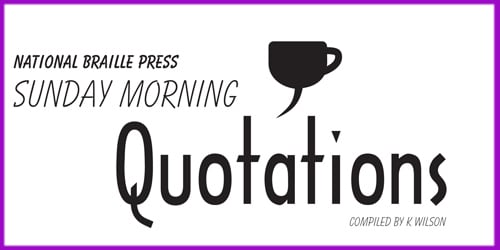By Mary Drain
When I stumbled upon the first quotation booklet NBP published several years ago, I knew I had to have it. Pocket-sized and spiral-bound, the booklet was sure to offer some interesting food for thought, and in a convenient size to boot. What I did not know at the time was that this booklet, and those that followed, would prove to be a valuable teaching tool. They offered just the right amount of content for many of my students to transition successfully from my curriculum-driven sentences to the reading of their first official braille publication.
For students of any age, moving from learning braille to comfortably using braille is a process. Appreciating braille for its utility, grace, and for the many jobs it does better than any other tool comes later. As someone who grew up with a tremendous amount of usable vision, I had no difficulty accessing print using a minimal amount of magnification. Never mind that my eyes fatigued easily and my reading speed was quite slow. It was my TVI who had the good sense and foresight to insist that I learn braille. When I asked why, he said, "Because I want you to have options."
Implicit in his response was a truth that I did not fully understand and embrace until I was much older. It is that achieving a level of proficiency with braille, audio, and, for some, magnification enables those of us who are visually impaired to choose the most efficient tool (or tools) for the task at hand, without ever having to compromise. As a braille teacher at the Orientation Center for the Blind in Albany, California, I feel fortunate to work alongside colleagues who share this point of view, and in a residential immersion training program that has our students working with these new tools of independence every day.

Nearly all of my students, most of whom are newly blind, begin my class eager to regain their ability to read and write independently. Whether having the goal of using braille to label, read a recipe, refer to notes when giving a school or workplace presentation, or read a book someday, very few of my students have to be convinced of braille's value. But, because learning braille more closely resembles the running of a marathon than a sprint, keeping my students motivated is not without its challenges. I am always mindful of proper pacing and the need for periodic pep talks.
For my students who have learned all of their contractions but need to continue to improve their reading, finding material that is both adult in nature and appropriate for their skill level has not always been easy. In the same way I would not throw a kid fresh out of driver's training onto a busy L.A. street during rush hour, I'm careful not to give my students reading material that is likely to frustrate or overwhelm them. With an average of five single-spaced lines of braille on each page (along with the attribution), each of the quotations in the quotation booklets are presented in a manageable format. They offer a terrific way to introduce my adult students to published braille. I look forward to seeing NBP produce more materials like this in the future. Riddles or fun facts anyone?
It seems only fitting that I conclude with a quote from Andrew Carnegie. He said, "Anything worth having in life is worth working for." I think we can all agree that this is certainly true when it comes to learning braille.
Mary Drain is one of ten credentialed teachers at the Orientation Center for the Blind. Operated by the California Department of Rehabilitation, the Orientation Center is a residential immersion program that offers classes in Orientation and Mobility, Adaptive Computer Training, Braille, Cooking, and Daily Living Skills to legally blind individuals who are clients of the California Department of Rehabilitation.
